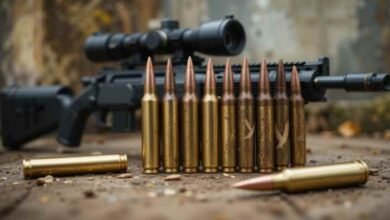Caseless Ammunition: The Future of Modern Firearms
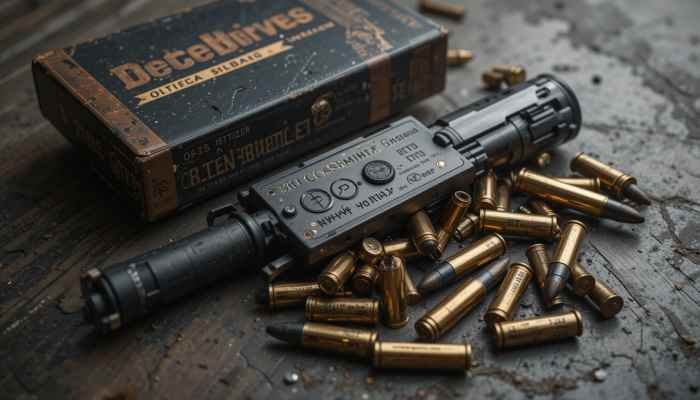
- Introduction to Caseless Ammunition
- What Is Caseless Ammunition?
- How Does Caseless Ammunition Work?
- Caseless Ammunition Diagram
- Caseless Ammunition G11: The Iconic Prototype
- 4.73×33mm Caseless Ammunition: Engineered for the G11
- LSAT Caseless Ammunition: America’s Turn
- Caseless Ammunition Rifles
- Caseless Ammunition Pistols: A Tougher Challenge
- Caseless Ammunition vs. Cased: Head-to-Head Comparison
- Caseless Ammunition Guns in Modern Development
- Modern Caseless Ammunition Advancements
- The Future of Caseless Ammunition
- Conclusion
Introduction to Caseless Ammunition
Caseless ammunition is an exciting new development in modern ballistics because it proposes a lighter, more efficient, and more straightforward firearm design solution. In a conventional cartridge, the bullet, gunpowder, and primer are contained in a metal cartridge case; caseless ammunition uses the propellant as a structural component. Therefore, no part of a casing is individually produced, and when ignited, the propellant burns out completely, leaving no remnants of evidence.
The idea was conceived in the Cold War era; it has become relatively more legitimate with military research programs, e.g., G11 from Germany and the LSAT from the United States. These military research programs have paved the way for advancements bold enough to embrace modern designs with caseless ammunition. Today, traditional cased ammo dominates the arming of nations in the present arms race. Yet, the culturally and technologically caseless methodology is a real thing that is progressing to the promise of one day leading to the lightest, fastest, and smartest weapons.
In this article, we will discuss caseless ammunition, how it works, how it is being applied, how it is compared to conventional rounds, how it is utilized in rifles and pistols, and how it looks for the future of ammunition with new evolutions.
What Is Caseless Ammunition?
Caseless ammunition refers to a type of firearm cartridge that does not use a metal casing to hold its components together. Instead, the round consists primarily of:
- Projectile (bullet): Typically a conventional lead or steel core.
- Propellant: A solid combustible block (usually nitrocellulose-based).
- Primer/Ignition System: Either embedded or attached to the propellant for initiation.
Caseless ammunition is designed to create a self-contained round completely consumed while firing. By removing the need to eject it from the weapon and for the gun, case storage is eliminated, simplifying the weapon design and potentially significantly increasing firing rates. Caseless ammunition has been considered a viable option for several decades but has largely faced major engineering problems that mainly stem from heat, fragility, and moisture resistance.
How Does Caseless Ammunition Work?
Caseless ammunition operates by igniting a solid propellant that houses the bullet and primer. Here’s how it functions step-by-step:
- Ignition: A firing pin or electronic pulse activates the primer.
- Combustion: The solid propellant block ignites, generating high-pressure gas.
- Projectile Motion: The bullet is propelled forward through the barrel.
- Full Burn: The casing is fully consumed—no ejection needed.
All the components, or rounds, rod here – there are no ejection or extraction processes that cut out moving parts, excess weight, and increase cyclic rate. On the downside, more heat is retained in the barrel because traditional ammunition dissipates heat, and the brass cases are discarded after firing.
Neither is there a casing, yet a round should be rugged enough to precision fit and chamber, bounce around or get dropped while also being able to take the pressure of very high chamber pressure – without the support of “Copper” or “Metal Casings.”
Caseless Ammunition Diagram
A simplified structural diagram of caseless ammunition would show:
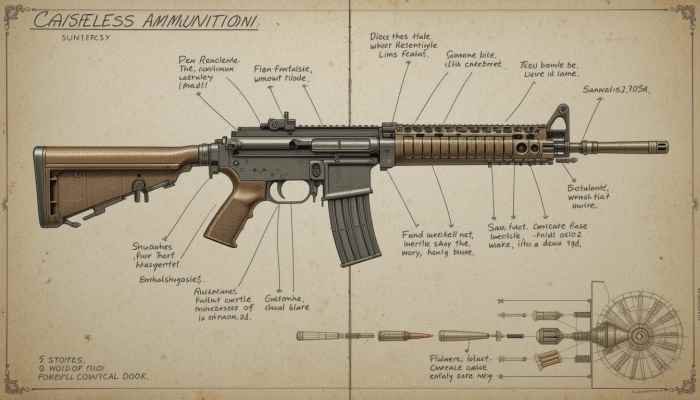
- Bullet (Top): Seated into the forward portion of the propellant block.
- Propellant Body (Middle): A dense, combustible block replacing the brass case.
- Primer (Rear): Positioned at the base or embedded within the propellant for ignition.
This monolithic structure replaces the multi-part assembly of traditional rounds. High-temperature-resistant coatings are sometimes added to protect the round from moisture and premature ignition.
Caseless Ammunition G11: The Iconic Prototype
The Heckler & Koch G11 is the most iconic caseless ammunition weapon ever developed. This advanced German rifle was engineered during the 1970s and 1980s and used a proprietary 4.73×33mm caseless ammunition round.
Key Features:
- Hyperburst mode: Fired 3 rounds at 2000 rounds per minute before recoil set in.
- Rotary chamber: Unique feeding system that chambered rounds horizontally.
- No ejection port: Because no cases needed to be expelled.
The G11 was years ahead of its time, capable of carrying more ammo and firing faster than any comparable rifle. However, it was not without flaws:
- Overheating: Sustained fire caused thermal issues.
- High cost: Manufacturing was expensive and complicated.
- Political shifts: The Cold War’s end reduced NATO’s urgency for new rifle systems.
Despite not entering full production, the G11 remains a landmark achievement and a major influence on future caseless designs.
4.73×33mm Caseless Ammunition: Engineered for the G11
This cartridge was purpose-built for the G11 rifle. Developed by Dynamit Nobel, the round featured a lightweight bullet seated into a rectangular block of solid nitrocellulose propellant.
Specifications:
- Caliber: 4.73mm
- Length: 33mm
- Weight: 6.5 grams (lighter than NATO 5.56mm)
- Muzzle Velocity: Approx. 930 m/s (3050 ft/s)
The 4.73×33mm round was designed to be:
- Heat-resistant: Capable of handling rapid bursts.
- Combustible: Fully consumed upon firing.
- Compact: Easy to stack and feed in the G11’s unconventional magazine.
It was one of the most sophisticated attempts at creating viable caseless ammunition, and its design continues to inspire modern variants.
LSAT Caseless Ammunition: America’s Turn
The Lightweight Small Arms Technologies (LSAT) program was launched by the U.S. Army to reduce the weight burden on soldiers. The program included two parallel paths:
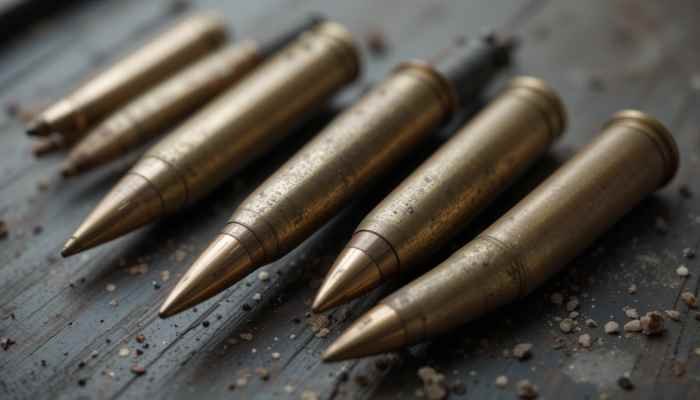
- Polymer-Cased Telescoped (PCT) ammunition
- Caseless Ammunition
The caseless rounds resembled the G11’s concept but incorporated modern materials and manufacturing processes. They aimed to reduce weight by 40% over conventional 5.56mm NATO rounds.
Highlights:
- Electronic ignition for precision.
- High-pressure tolerant propellant blocks.
- Heat shielding coatings to prevent cook-off.
Challenges:
- The same thermal and durability issues persisted.
- The polymer-cased path was considered more practical and scalable.
Though the caseless track was eventually paused, LSAT left behind crucial advancements in material science, ignition control, and round stability, shaping future small arms development.
Caseless Ammunition Rifles
Most caseless systems have been explored through rifles, which are better suited to handle the thermal and mechanical demands.
Notable Rifles:
- H&K G11: The pioneer.
- LSAT Rifle: Lightweight and modular.
- Russian OTs-20 (prototype): Explored high-caliber caseless options.
- DARPA and Textron Concepts: Testing smart integration and advanced ignition.
Rifles benefit from:
- Better heat dissipation (larger barrel mass).
- Stronger firing mechanisms for ignition.
- Space for electronic ignition or rotary chambers.
Caseless rifles continue to be the primary focus of research due to their performance and operational potential.
Caseless Ammunition Pistols: A Tougher Challenge
Caseless pistols are rarer due to more restrictive form factors and thermal limitations.
Key Obstacles:
- Compact design: Less material to absorb heat.
- Manual cycling: Requires robust rounds that can withstand chambering force.
- Magazine pressure: Rounds must not ignite accidentally under compression.
Despite this, there have been some experimental attempts:
- Voere VEC-91: An Austrian electronic-ignition rifle using caseless ammo, though not a pistol.
- Civilian defense concepts: Lightweight survival pistols with caseless technology are being explored in labs and startups.
Caseless pistol development is advancing slowly, awaiting better propellant stabilization and miniaturized ignition systems.
Also Read: Sitka Gear: Your Guide to Premium Outdoor Performance Wear
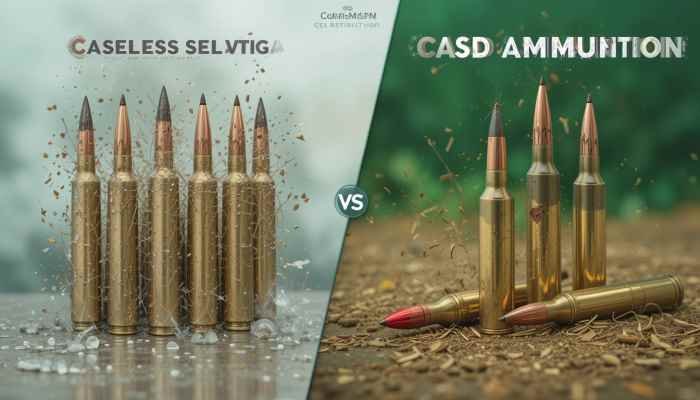
Caseless Ammunition vs. Cased: Head-to-Head Comparison
| Feature | Caseless Ammo | Cased Ammo |
| Weight | Up to 40% lighter | Heavier due to brass/steel cases |
| Ejection | Not required | Mandatory after each shot |
| Firing Rate | Higher potential | Slower due to mechanical cycling |
| Heat Dissipation | Lower (retains heat) | Better (case absorbs heat) |
| Durability | More fragile | Highly durable |
| Moisture Resistance | Needs coatings | Built-in with sealed casings |
| Reloading | Not feasible | Common in civilian use |
Caseless systems offer superior performance in theory, but current real-world conditions still favor cased rounds for reliability, handling, and affordability.
Caseless Ammunition Guns in Modern Development
While no caseless firearm is in wide commercial use, ongoing projects are being developed by:
- Textron Systems: Successor to LSAT, continuing small arms R&D.
- DARPA: Integrating smart tech with next-gen weapons.
- Private Defense Contractors: Exploring hybrid designs with polymer casings and partial caseless elements.
Some advanced guns may not use fully caseless designs but apply caseless principles, such as:
- Combustible case walls
- Electronic ignition
- Smart-firing modules
Civilian prototypes are rare due to safety, cost, and regulation concerns, but defense sectors remain interested.
Modern Caseless Ammunition Advancements
New innovations are tackling the classic limitations of caseless ammo:
1. Advanced Propellants
- High-strength, low-heat signature materials.
- Better shelf life and reduced cook-off risk.
2. Electronic Ignition
- Greater firing control and reduced misfires.
- Integration with digital optics and smart systems.
3. 3D Printing
- Custom molds for one-piece round manufacturing.
- Lower cost for prototyping and testing.
4. Hybrid Ammo
- Combining the best of polymer-cased and caseless rounds.
- Examples include telescoped rounds with semi-combustible components.
These innovations show a clear trajectory toward practical, scalable caseless technology in the near future.
The Future of Caseless Ammunition
While challenges remain, the case for caseless ammo is strengthening:
- Tactical Advantage: Soldiers can carry more rounds without added weight.
- System Simplification: Fewer moving parts, less chance of mechanical failure.
- Smart Integration: Caseless rounds work well with next-gen smart weapons.
However, broader adoption will depend on:
- Solving heat issues in automatic fire.
- Creating rounds stable enough for battlefield use.
- Ensuring manufacturing is cost-effective and safe.
It may take another decade, but the momentum behind lightweight, efficient, and smart ammunition suggests caseless tech will eventually become mainstream.
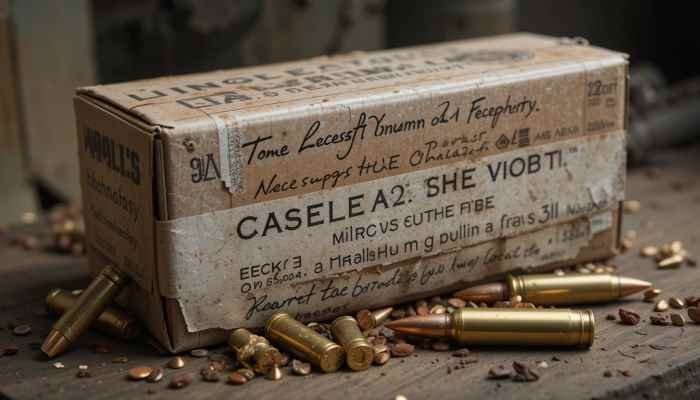
Conclusion
Caseless ammunition is not just science fiction—it’s a real and complex new branch of firearms technology. From the Volkswaffe G11 and its ambitious 4.73×33mm rounds to the more recent LSAT programs and more, there has been enormous promise in caseless ammo: reduced weight, increased firing rate, and simpler functioning make it a compelling substitute for conventional ammunition. For widespread adaptation to occur, however, it must overcome its most significant hurdles: heat, durability, and reliability. With the application of new data in advanced materials, electronics, and weapon integration, caseless ammo is getting closer to deployment. It is now possible to see the end of brass in firearms within the next 10 years!


